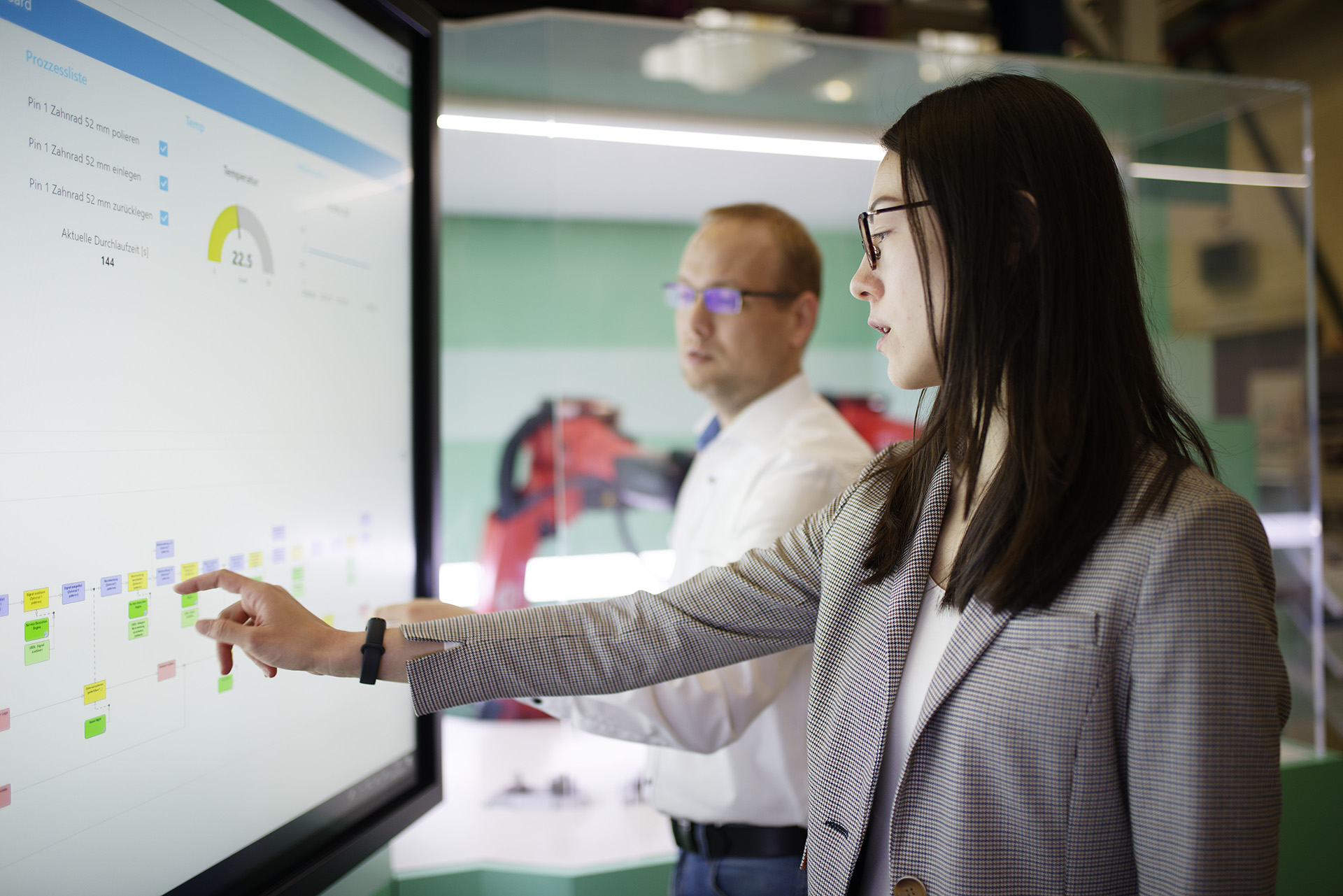Jahr
Year | Titel/Autor:in
Title/Author | Publikationstyp
Publication Type |
|---|
| 2026 |
Digital Twin for Automated Post-processing Chain in Additive Manufacturing
Nguyen, Sissy-Linh; Ahmed, Omnya; Joost, Robert; Lünnemann, Pascal; Larusch, Terence |
Konferenzbeitrag
Conference Paper
|
| 2025 |
Challenges and Lessons Learned for Industry Transfer of DPP Solutions
Manoury, Marvin Michael; Wiesner, Malina; Riedelsheimer, Theresa; Honsberg, Finn; Lindow, Kai |
Konferenzbeitrag
Conference Paper
|
| 2025 |
3D Data Integration in the Digital Twin for Circular Economy
Stollenwerk, Matthias; Joost, Robert; Riedelsheimer, Theresa; Lindow, Kai |
Zeitschriftenaufsatz
Journal Article
|
| 2025 |
From Stakeholder Needs to Secure Digital Twin Services: Critical Infrastructure Use Cases within the INTACT Framework
Burdulea, Ilinca-Laura; Gogineni, Sonika; Kostopoulos, Stamatios; Markakis, Evangelos K.; Manganaris, Kyriakos N.; Lazarakis, Fotis I. |
Konferenzbeitrag
Conference Paper
|
| 2024 |
Energieeffizienzsteigerung mit IoT-basiertem Monitoringsystem
Uhlmann, Eckart; Polte, Julian; Geisert, Claudio |
Zeitschriftenaufsatz
Journal Article
|
| 2024 |
Digital Twins within the Circular Economy: Literature Review and Concept Presentation
Mügge, Janine; Seegrün, Anne; Hoyer, Tessa-Katharina; Riedelsheimer, Theresa; Lindow, Kai |
Zeitschriftenaufsatz
Journal Article
|
| 2024 |
Developing Digital Twins for energy efficiency in the production phase of products
Wehking, Sebastian; Riedelsheimer, Theresa; Tanrikulu, Cansu; Lindow, Kai |
Zeitschriftenaufsatz
Journal Article
|
| 2024 |
Sustainable Product Lifecycle Management - Implementation of a Digital Twin of a Biologically Transformed Product-Ecosystem
Wehking, Sebastian; Seegrün, Anne; Riedelsheimer, Theresa; Lindow, Kai |
Zeitschriftenaufsatz
Journal Article
|
| 2024 |
Was macht einen digitalen Zwilling aus?
Lindow, Kai; Tanrikulu, Cansu |
Zeitschriftenaufsatz
Journal Article
|
| 2024 |
Konzeption eines digitalen Zwillings für die Produktentstehung in der Luftfahrtindustrie
Brünnhäußer, Jörg; Jurczok, Christoph; Zimmermann, Thomas; Larusch, Terence; Kenfack Zangue, Renaud; Böhnke, Jacob; Lünnemann, Pascal; Lindow, Kai |
Konferenzbeitrag
Conference Paper
|
| 2024 |
Concept for a modular system model for energy-efficiency monitoring of factory supply systems
Sigg, Stefan; Thiele, Gregor; Trapp, Marvin; Krüger, Jörg |
Konferenzbeitrag
Conference Paper
|
| 2024 |
Value co-creation through digital twins in decentralized data ecosystems
Tanrikulu, Cansu; Berg, Henning; Konietzko, Erik Paul; Rosa Cencic, Maiara; Lindow, Kai |
Konferenzbeitrag
Conference Paper
|
| 2024 |
Developing Digital Twins for Smart Product-Service Systems:A Methodical Approach Demonstrated with a Fuel Cell Use Case
Kenfack Zangue, Renaud; Gogineni, Sonika; Geisert, Claudio |
Konferenzbeitrag
Conference Paper
|
| 2023 |
Sustainable product lifecycle management with Digital Twins: A systematic literature review
Seegrün, Anne; Kruschke, Thomas; Mügge, Janine; Hardinghaus, Louis; Knauf, Tobias; Riedelsheimer, Theresa; Lindow, Kai |
Zeitschriftenaufsatz
Journal Article
|
| 2023 |
Digital Twin for Circular Economy
Mügge, Janine; Riedelsheimer, Theresa; Lindow, Kai |
Konferenzbeitrag
Conference Paper
|
| 2023 |
Implementing digital twins in existing infrastructures
Lünnemann, Pascal; Lindow, Kai; Goßlau, Leo |
Zeitschriftenaufsatz
Journal Article
|
| 2023 |
Smarte Überwachung elektrischer Großantriebe
Geisert, Claudio; Polte, Julian; Uhlmann, Eckart; Rauch, Hartmut; Brach, Karsten |
Zeitschriftenaufsatz
Journal Article
|
| 2023 |
End-of-life decision support to enable circular economy in the automotive industry based on digital twin data
Mügge, Janine; Hahn, Inka Rebekka; Riedelsheimer, Theresa; Chatzis, Johannes; Boes, Joachim |
Zeitschriftenaufsatz
Journal Article
|
| 2023 |
Blue Print Plant Model. Ein Modell zur Unterstützung des Fabrikplanungsprozesses
Lange, Annika; Ihnen, Deike Magret; Knothe, Thomas |
Zeitschriftenaufsatz
Journal Article
|
| 2023 |
The Digital Twin for Operations, Maintenance, Repair and Overhaul
Lünnemann, Pascal; Fresemann, Carina; Richter, Friederike |
Aufsatz in Buch
Book Article
|
| 2023 |
Empowering End-of-Life Vehicle Decision Making with Cross-Company Data Exchange and Data Sovereignty via Catena-X
Mügge, Janine; Große Erdmann, Julian; Riedelsheimer, Theresa; Manoury, Marvin Michael; Smolka, Sophie Odette; Wichmann, Sabine; Lindow, Kai |
Zeitschriftenaufsatz
Journal Article
|
| 2023 |
F5G OpenLab: Enabling Twin Transition through Ubiquitous Fiber Connectivity
Balanici, Mihail; Shariati, Mohammad Behnam; Safari, Pooyan; Chojecki, Paul; Chemnitz, Philipp Axel Moritz; Przewozny, David; Fischer, Johannes; Freund, Ronald |
Konferenzbeitrag
Conference Paper
|
| 2023 |
Project-Based Learning in Engineering Education - Developing Digital Twins in a Case Study
Hagedorn, Lisa; Riedelsheimer, Theresa; Stark, Rainer |
Zeitschriftenaufsatz
Journal Article
|
| 2023 |
Smart Maintenance - Was ist das und was kann es?
Geisert, Claudio |
Zeitschriftenaufsatz
Journal Article
|
| 2023 |
Digital Twins for Sustainability in the Context of Biological Transformation
Seegrün, Anne; Mügge, Janine; Riedelsheimer, Theresa; Lindow, Kai |
Konferenzbeitrag
Conference Paper
|
| 2022 |
Resource efficient production of car body parts - implementation of digital twins across process chains
Weber, Joshua; Lemke, Josefine; Sunderkoetter, Christina; Haase, Patrick; Hoefemann, Matthias; Joos, Paul; Merklein, Marion |
Vortrag
Presentation
|
| 2022 |
A cognitive assistance system with augmented reality for manual repair tasks with high variability based on the digital twin
Eversberg, Leon; Ebrahimi, Puya; Pape, Martin; Lambrecht, Jens |
Zeitschriftenaufsatz
Journal Article
|
| 2022 |
Harmonization of Heterogeneous Asset Administration Shells
Koutrakis, Nikolaos-Stefanos; Gowtham, Varun; Pilchau, W.B.P. von; Jung, T.J.; Polte, Julian; Hähner, J.; Corici, Marius-Iulian; Magedanz, Thomas; Uhlmann, Eckart |
Zeitschriftenaufsatz
Journal Article
|
| 2022 |
The Use of Digital Twins to Overcome Semantic Barriers in Hyperconnected Ecosystems for Industry
Jäkel, Frank-Walter; Gering, Patrick; Knothe, Thomas |
Konferenzbeitrag
Conference Paper
|
| 2022 |
Application of Uncertainty-Aware Sensor Fusion in Physical Sensor Networks
Gruber, Maximilian; Pilar von Pilchau, Wenzel; Gowtham, Varun; Koutrakis, Nikolaos-Stefanos; Schönborn, Nicolas; Eichstädt, Sascha; Hähner, Jörg; Corici, Marius-Iulian; Magedanz, Thomas; Polte, Julian; Uhlmann, Eckart |
Konferenzbeitrag
Conference Paper
|
| 2022 |
Digital Twins for Circular Economy - Enabling Decision Support for R-Strategies
Mügge, Janine; Hahn, Inka Rebekka; Riedelsheimer, Theresa; Chatzis, Johannes |
Zeitschriftenaufsatz
Journal Article
|
 Fraunhofer Institute for Production Systems and Design Technology
Fraunhofer Institute for Production Systems and Design Technology
